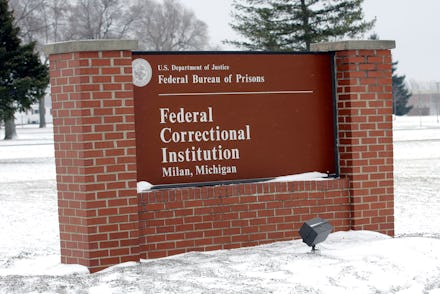Is coronavirus falling harder on Black prisoners? Officials won't say

This article was originally published by The Marshall Project, a nonprofit news organization covering the U.S. criminal justice system. Sign up for their newsletter, or follow The Marshall Project on Facebook or Twitter.
Every day we learn a little more about how the devastation of the COVID-19 pandemic has fallen more heavily on Black Americans, as researchers examine unequal death rates and discuss how policy decisions are shaping the virus’s disparate toll.
But when it comes to prisons — which have emerged as catalysts for the virus’ spread — we are mostly flying blind.
Last month, The Marshall Project asked prison officials from all 50 states and the federal government for the races of people in prisons tested for, diagnosed with or killed by COVID-19. Forty-three prison agencies, including the Federal Bureau of Prisons, could not or would not provide this information. “We are simply not organizing data in that manner currently,” said a spokesperson in New Hampshire. One in Kansas wrote in an email, "We do not have plans to release any additional demographics other than their rough age (over the age of 50, 60, etc.) and gender.” Nine agencies did not respond at all to repeated requests.
Only Vermont provided all of the data we asked for. Michigan gave us some, while six states — Delaware, Maine, Missouri, Oklahoma, Tennessee, and West Virginia — gave us a little. We asked several epidemiologists to react to these limited glimpses.
Monik Jiménez, an epidemiologist at Harvard Medical School, called the failure to capture this data “another form of structural racism.” Without such breakdowns, she explained, officials are unable to plan or to find “culturally relevant interventions” such as Spanish-language education on social distancing. They also can’t respond to higher rates of pre-existing health conditions among Black prisoners, such as high blood pressure and diabetes.
It is impossible to know if some of these states are failing to track the data, or simply refusing to make it public. Officials in a few states told our reporters they would need to file public records requests, although a Texas official said the request would likely be denied. New Jersey refused our request, while New York told us to wait until August for a response.
But the limited data available suggest that while Black people are more likely to contract COVID-19, as well as die from the virus, outside prisons, they may be even more likely to do so behind bars.
Consider Michigan, one of the only states that has tested every single prisoner for COVID-19. Black residents comprise just 14% of the state’s overall population, but roughly half of the state’s prisoners. (Michigan does not keep up-to-date statistics about race in its prison population, but in 2018 put this figure at 53%.) When COVID-19 swept several of the state’s prisons, it hit Black prisoners even worse than black residents outside prison: By Thursday, 48% of prisoners who had died were Black, compared with 40% of people who died in the state overall.
“There is a bottlenecking happening,” said Barun Mathema, an epidemiologist at Columbia University. “People of color are being incarcerated at far higher rates than their counterparts, while neighborhoods that are economically or politically disenfranchised will also have an accumulation” of health factors that make them more vulnerable to COVID-19.
Black prisoners in Michigan have accounted for 49% of positive COVID tests, at the same time Black residents received 31% of positive tests in the state as a whole.
Other state prison systems have fewer COVID infections but larger racial disparities:
- As of May 13, Black prisoners accounted for 25 of 43 positive tests in Missouri prisons, or 58%. They comprised only one-third of the prison population (in June of last year, the most recent data available).
- In Vermont, by May 20, Black prisoners accounted for 18% of positive tests, even though they only make up 9% of the prison population (and just 1% of the state’s population is Black).
These numbers raise all kinds of questions that would help public health researchers guide policy. “You want to ask, ‘Are they doing more poorly because of accumulation of risk factors?’” Mathema said. “Or is it that they are presenting later, and more severely, because they are not being given the attention they need?”
We know people in prison have different health problems from their peers outside. We also know that racial biases affect medical care outside prisons. “What I would want to see is: Are there patterns in correctional facilities of who tests are provided to?” said Zinzi Bailey, a social epidemiologist at the University of Miami. “It’s not like you get incarcerated and suddenly racism doesn’t exist; it’s a microcosm of the larger situation.”
A concern about bias is partially what motivated Vermont officials to keep tabs on the racial impact of COVID-19 behind bars. The Vermont Department of Corrections “is committed to activities that will reduce implicit bias in our decision making,” said spokeswoman Rachel Feldman, noting that the agency and the state government as a whole “acknowledge there is a disproportionate number of people of color incarcerated in Vermont.”
Mathema, the Columbia University epidemiologist, hopes the role of prisons and jails as hotspots during this pandemic will help his peers, and the public, realize how crucial these institutions are to our overall public health, even in the best of times. “No matter how many bars we have, prisons are breathing systems,” he said. “A pandemic raises up these things that have always been there.”
Additional reporting by Cary Aspinwall, Keri Blakinger, Andrew R. Calderón, Eli Hager, Jamiles Lartey, Nicole Lewis, Weihua Li, Joseph Neff, Alysia Santo, Beth Schwartzapfel, Christie Thompson, Abbie VanSickle.